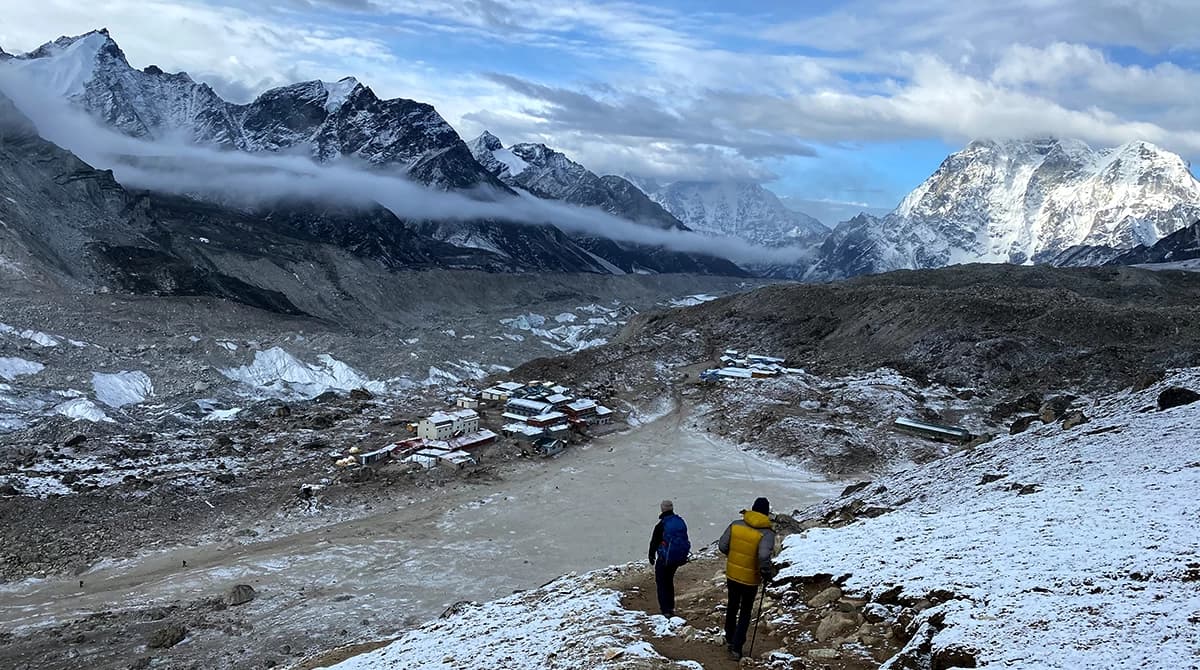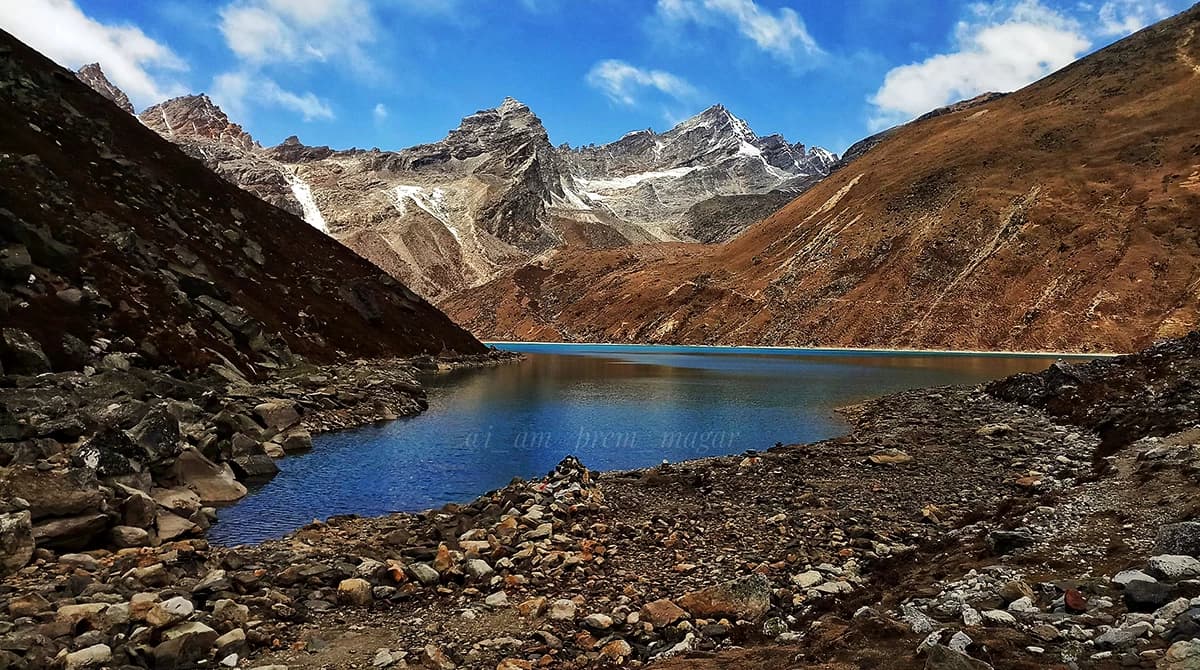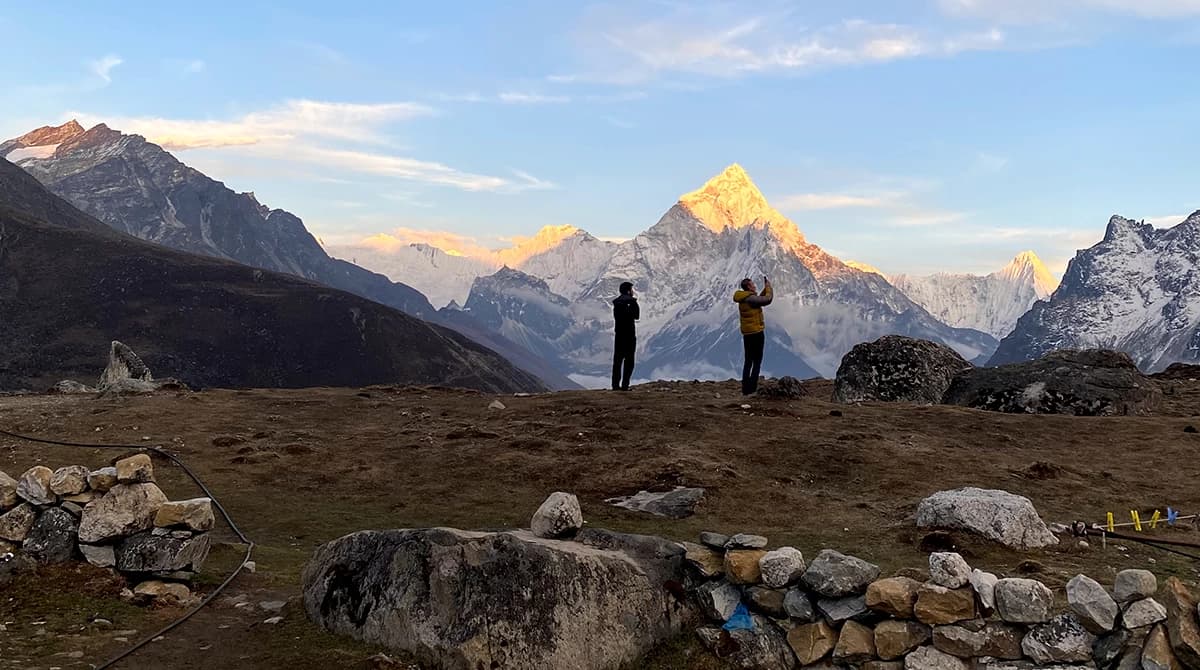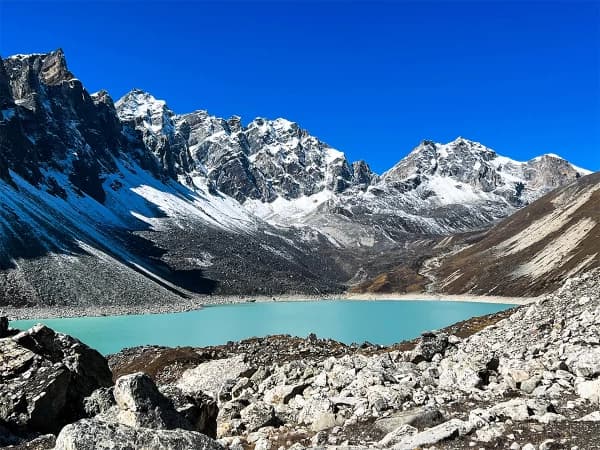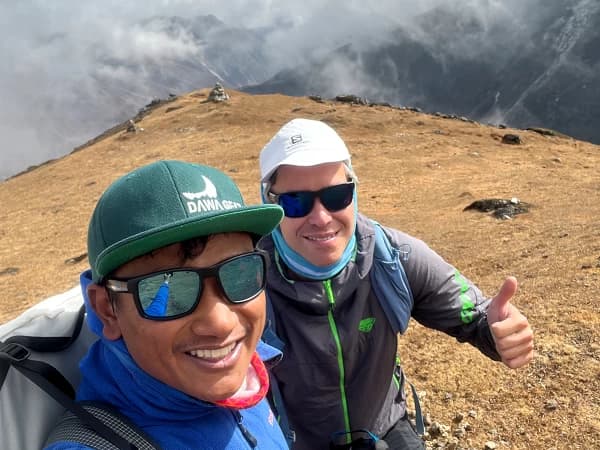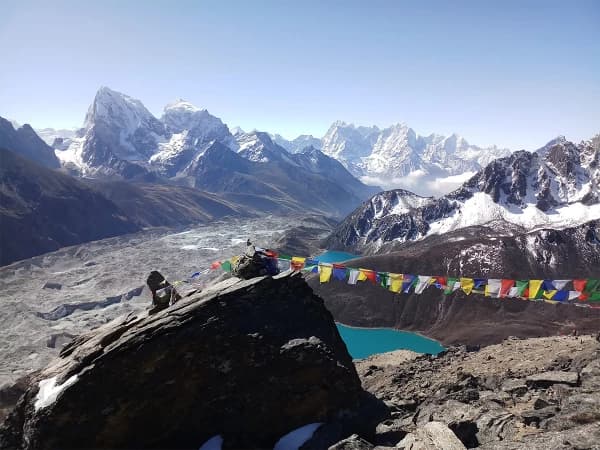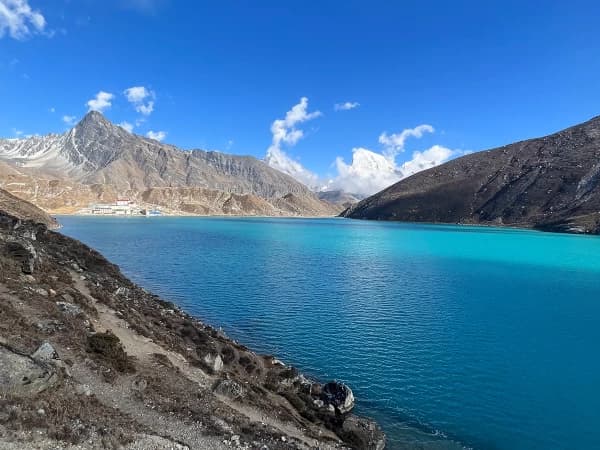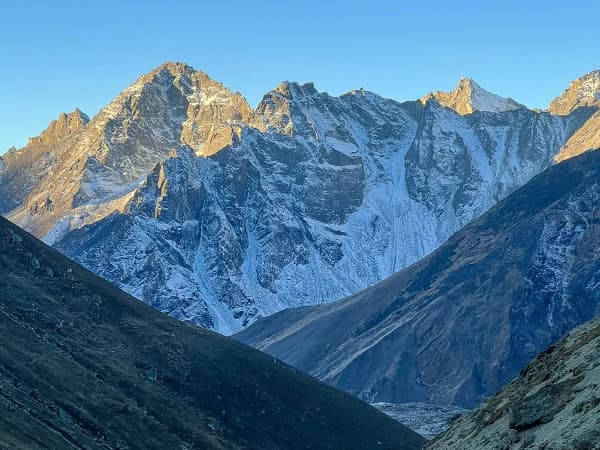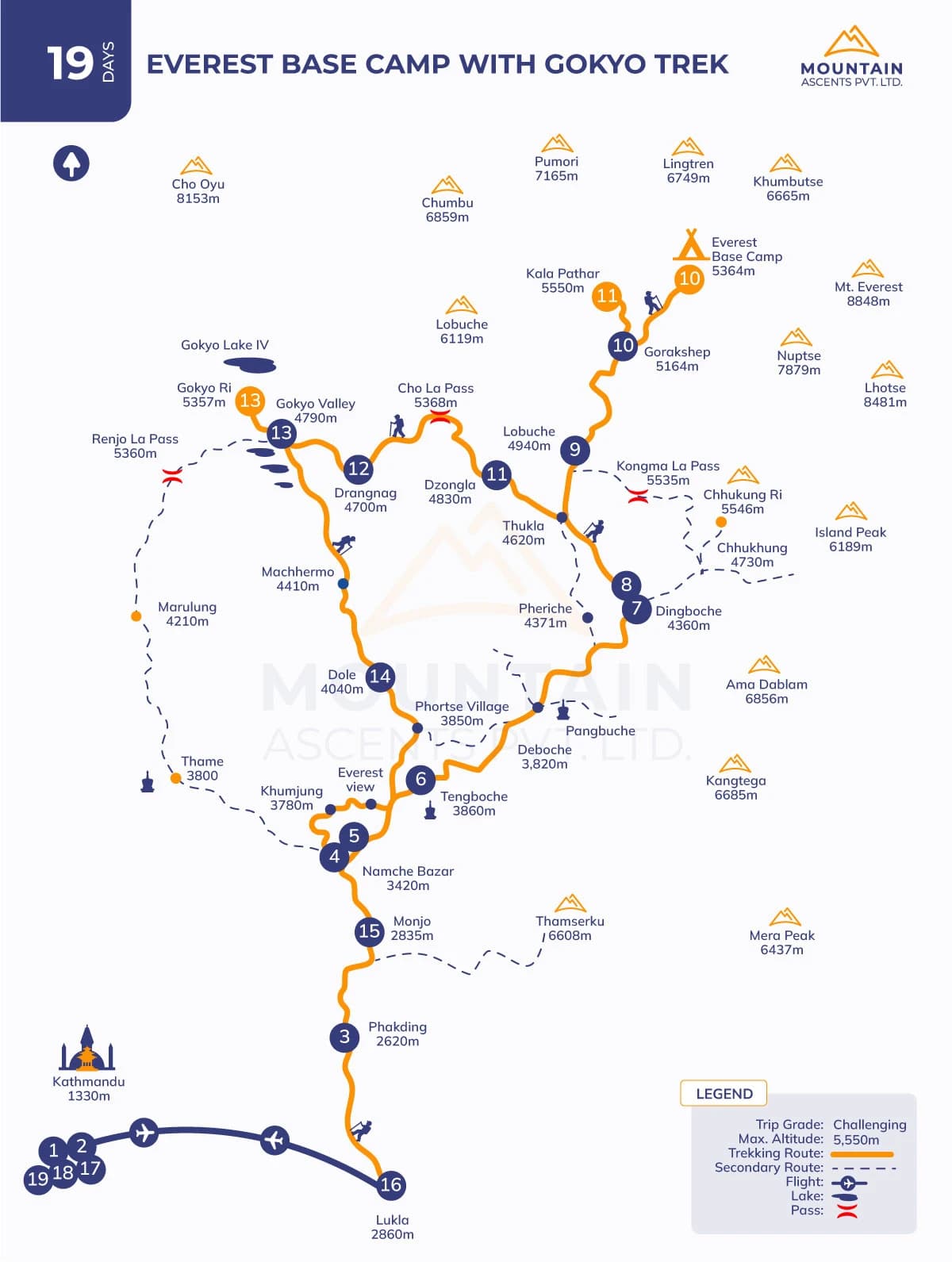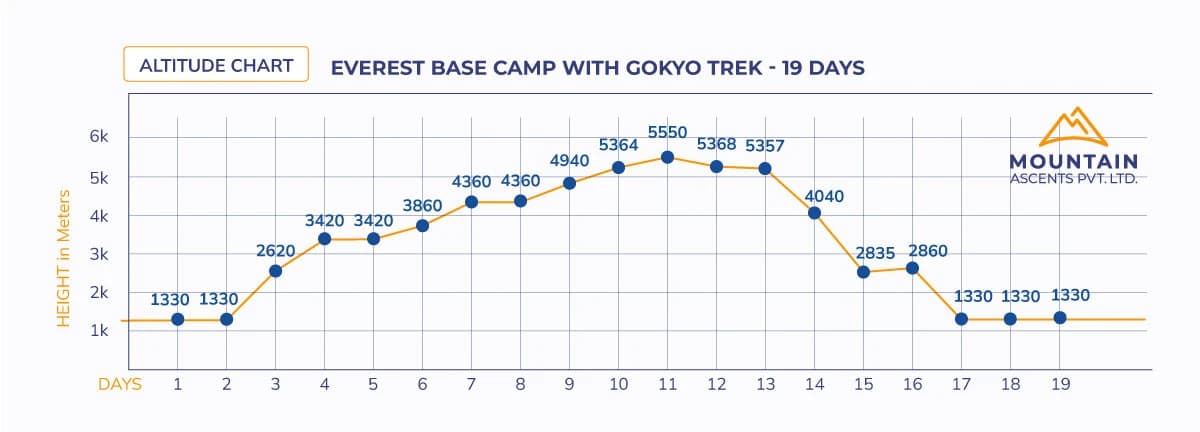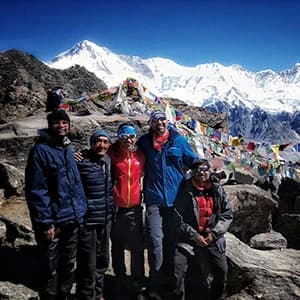The Everest Base Camp with Gokyo Trek is a fascinating, remarkable, and adventurous journey through the Khumbu/Everest Himalayas of Nepal that combines the region’s most iconic destination in one single trip: the classic Everest Base Camp Trekking Trail and the tranquil Gokyo Lake. This Himalayan expedition presents you with equal challenge and reward and is a round trip with only a few retracings of the route involved. Commencing typically with an adrenaline-rushing mountain flight to Lukla from Kathmandu or Manthali during the peak trekking season in spring and autumn, this epic adventure will take you through some of Nepal's most stunning landscapes, providing a one-of-a-kind combination of natural beauty, cultural immersion, and exciting trekking experiences.
This combined trek includes crossing the Khumbu Glacier, the largest glacier in the Himalayas; hiking to Kala Patthar, the highest trekking point of the classic Everest Base Camp Trek with the closest view of Mount Everest; traversing the Cho La Pass, at 5,420 m above sea level; and unwinding around the serene alpine Gokyo Lake and adjacent Gokyo Ri Peak. Since it is high-altitude trekking that involves walking 5-7 hours each day at low oxygen levels, the voyage is best done in the months of spring and autumn, i.e., March through May and September through November. Along the way, trekkers get to experience the genuine and warm hospitality of the Sherpa people, a visual feast of varying yet striking landscapes, and gain insights into Buddhist traditions, customs, and culture.
Trekkers begin foot walking from Lukla, the entrance to the Everest area, and make their way along the famed Caravan Route, passing through beautiful villages like Phakding, Namche Bazaar, and Tengboche, where you will visit Tengboche Monastery, the biggest monastery in the entire Khumbu Region. Along the trekking trail, you will pass renowned landmarks like Dingboche, Lobuche, and Gorak Shep, and you will be able to marvel at the majestic Himalayan peaks, including Everest. The adventure doesn't stop there: you'll climb to the height of Kala Patthar for an unforgettable view of the Top of the World and surrounding peaks. From there, you will take a special route through Zhongla, over the challenging Cho La Pass, and into the peaceful Gokyo Valley. There, you can enjoy the calm beauty of Gokyo Lake and reach the top of Gokyo Ri for a view of the whole Himalayan range.
Finally, as you leave the mountains and return to Kathmandu, you will celebrate your epic adventure with a traditional Nepali farewell dinner and cultural program, ensuring that your memories of this incredible trek remain for a lifetime. Come along on an incredible journey that will blend the highlights of Gokyo Valley and Everest Base Camp, creating experiences that will last a lifetime and stories that will be passed down through generations. Join Mountain Ascents on an unforgettable Himalayan Odyssey offering the best itinerary, affordable package, and reliable support from experts.
Trip Highlights
- Visit UNESCO World Heritage Sites and the tourist hub of the capital city of Nepal, Kathmandu.
- A scenic 25-40 minute flight from Kathmandu to Lukla and Lukla to Kathmandu presents an awesome, unique perspective of the Everest mountain giants and surrounding Himalayas.
- Follow the classic Everest Base Camp Trekking Trail once traversed by the legendary mountaineers Sir Edmund Hillary and Tenzing Norgay Sherpa.
- Observe the wide range of flora and fauna of the Sagarmatha National Peak, including some rare mammals like red pandas, musk deer, snow leopards, and Himalayan tahr.
- Get an insider insight into the day-to-day life of famed Sherpa, also known as the “Tigers of snow.”.
- An opportunity to witness the cultural beauty of diverse ethnic communities of the Everest Himalayas, mostly rooted in Tibetan Buddhism, is showcased by vibrant prayer flags, mani stones, prayer wheels, gompas, monasteries, and typical stone-roofed houses.
- Embrace the true Himalayan spirit with a hike to the group of five freshwater alpine Gokyo lakes through the Cho La Pass in isolation from massive tourism.
- Epic side hike to Kala Patthar and Gokyo Lake with 360-degree expansive views of the neighboring Himalayan peaks.
- Everlasting panoramic views of Ama Dablam, Everest, Nuptse, Lhotse, Pumori, and other snow-capped mountain ranges throughout the trek.
- Walk through the astonishing mountain valleys, slopes, natural springs, lush forests, and typical mountain settlements.
What makes Everest Base Camp with Gokyo Lake Trek special?
Often also referred to as the Gokyo Lake Trekking, the Everest Base Camp with Gokyo Trekking stands out for various reasons, specifically the combination of natural wonders, cultural experiences, and physical challenges best suited for individuals seeking more isolated, raw, and high-altitude adventure. This fused Himalayan voyage in Nepal includes a visit to the serene Gokyo Lakes, a climb to Gokyo Ri, and the crossing of the dramatic Cho La Pass with a trek to the Everest Base Camp and Kala Patthar.
Throughout the journey, you will be rewarded with the mythical Himalayan views, tranquility, and cultural pilgrimages, also offering a deep immersion into the Sherpa way of life with stops at several mountain villages like Namche Bazaar, Tengboche, and Gokyo, featuring high-altitude trails, tea houses, and landmarks with cultural and spiritual importance nestled in the peaceful Himalayan ambiance. As you walk past the Sagarmatha National Park, the encounter with diverse wildlife adds much to the amusement for nature lovers along the changing landscapes that come with rapid differences in weather, scenery, and climatic conditions. Altogether, here’s what you can expect during the Everest Base Camp with Gokyo Lake Trek:
Iconic Himalayan Views
The distant views of the snow-capped mountain ranges will greet you upon your arrival in Kathmandu, Nepal. Once you board the mountain flight to Lukla, you will be stunned with the first glimpses of the Everest Himalayas, followed by that of lush green valleys, traditional Nepali villages, rivers, and waterfalls. Serving as the gateway and trek starting point to several adventurous trekking and climbing routes in the Everest region, such as the Three High Pass Trek, Mera Peak Climbing, and Island Peak Climbing, including the Everest Base Camp with Gokyo, Lukla has magnificent first glimpses of Kusum Kanguru and Thamserku.
As you head to Namche Bazaar, the infamous Sherpa capital, you can grasp the panorama of peaks like Kongde Ri, Thamserku, and Everest afar. The typical mountain village's similarly has clear views of Ama Dablam, Everest, and Lhotse, while Dingboche is noted for the dramatic peaks of Island Peak, Lhotse, and the famous north face of Ama Dablam. Though the Everest Base Camp doesn't offer direct views of the top of Mount Everest, the Khumbu Icefall, glaciers, and glorious views of Nupse and Pumori are truly awe-inspiring.
Besides these, situated in high altitudes, other iconic landmarks like Kala Patthar (5,545 m), Gokyo Lakes and Gokyo Ri (5,357 m), Cho La Pass (5,420 m), and Ngozumpa Glaciers also feature the nonstop charm of the snow-clad mountain peaks. Kala Patthar specifically is famous for its best close-up views of Everest and other sky-perching mountains like Lhotse, Nuptse, Changtse, and Pumori, especially during sunset and sunrise, resulting in its nickname, the ultimate Everest viewpoint.
Riveling Kala Patthar, also the highest point of the Everest Trekking, is Gokyo Ri, presenting trekkers with the hidden gem, the turquoise beauty of Gokyo Lakes, and heavenly views of Everest, Makalu, Lhotse, and Cho Oyu, and that of the longest glacier in the Himalayas, the Ngozumpa Glacier. Cho La Pass, on the other hand, offers you incredible views of Ama Dablam, Cholatse, and surrounding peaks along with icy and rugged terrain, making it a challenging high-altitude pass, rewarding immensely. From Ngozumpa Glacier is the mesmerizing sight of ice formations and surrounding peaks.
Overall, often referred to as the “Matterhorn of the Himalayas,” Ama Dablam dominates the skyline for much of the Everest Base Camp with Gokyo Lake Trekking. The highest mountain in the world, Mt. Everest (8,848 m), is visible from various vantage points, while Makalu and Cho Oyu, part of the “Eight-Thousanders Club,” create a visible feast for the eyes and soul from Gokyo Ri, making the entire trip worthwhile.
The natural paradise of the Sagarmatha National Park
Established in the year 1976, encompassing an area of 1,148 square km in the Solukhumbu district, the Sagarmatha National Park is one of the major highlights of the Himalayan voyage to the Everest Base Camp with the Gokyo Trek. Ranging from an altitude of 2,845 m in Monjo to 8,848 m in Everest’s summit, the national park area is home to wide ranges of flora and fauna, including dense rhododendron forests, pine trees, musk deer, Himalayan Tahr, snow leopards, and Himalayan Monals (the national birds of Nepal).
Designated as the UNESCO World Heritage Site, it consists of a 275 square kilometer buffer zone and is known for conservation efforts of forests, wildlife, and cultural resources. The national park shares international borders with Chomolungma National Nature Preserve in the Tibet Autonomous Region and Makalu Barun National Park in the east, while it extends to Dudh Koshi River in the south, featuring marvelous glaciers, deep valleys, and peaks like Mount Everest, Ama Dablam, Lhotse, Cho Oyu, Khumbu Icefall, and Ngozumpa Glacier, catering to the interests of nature lovers, mountaineers, and trekkers alike.
For photography and wildlife enthusiasts, the national park is heaven, offering unparalleled natural beauty, biodiversity, and encounters with several wild species, some even listed on the endangered list worldwide.
Walking through the diverse landscape of the Everest Himalayas
The combined trek to Everest Base Camp with Gokyo Lake takes you through a rich tapestry of natural beauty, beginning in the lush, green lowlands, filled with subtropical forests of rhododendron and pines, gushing rivers, streams, and waterfalls, to alpine meadows and rugged terrain in stark contrast to the snow-covered mountain ranges like Ama Dablam, Lhotse, Kusaum Kangru, and many others; this trek has a lot to offer.
As you ascend to high-altitude Everest Base Camp, Kala Patthar, Gokyo Lake, Gokyo Ri Peak, Cho La Pass, and Ngozumpa Glacier, making your way through the low-altitude villages showcasing strong cultural ties to Tibet, trekkers can witness the scenic transformation in landscape characterized by vast rocky moraines, glacial rivers, glowy Gokyo Lakes, and the dramatic contrast of icy glaciers against the otherworldly backdrop of snow-capped peaks, forming an unmatchable sight to behold.
With the occasional encounters with Himalayan wildlife, experiencing the first-hand hospitality of Sherpa people and other ethnic communities of Nepal inhabiting the Everest Himalayas, the trek’s diversity, from lush valleys to high-altitude wonders offering a true sense of serenity and achievement, makes this Everest Base Camp with Gokyo Trek truly an unforgettable journey to experience atleast once.
Rich Cultural Exploration
The Everest Base Camp with Gokyo Lake Trekking Trail passes through several typical Himalayan villages like Namche Bazar, Tengboche, Dingboche, Lobuche, and Dzongla, offering insight into its vibrant Sherpa heritage. The Everest region, specifically the Upper Himalayan land, is precisely dominated by Sherpa people, known for their mountaineering legacy and warm hospitality.
Bearing its own distinctive lifestyle, traditions, culture, attires, and dialects, the journey to Everest Base Camp and later to Gokyo Lake offers insight into their daily lives, mostly guided by Tibetan Buddhism. On the way, trekkers can visit several gompas and monasteries where colorful local festivals, celebrations, and occasions are held every year featuring traditional dances and blessings.
One such is Mani Ridum in the Tengboche Monastery at an altitude of 3,867 m/12,687 ft. It is the largest monastery in the Everest Region, a spiritual center perfect for meditation, yoga, and practicing mindfulness, adding much to the spiritual aspect before heading to the hidden valleys and gems of the Gokyo Valleys, lakes, and peaks with comparatively less traversed routes.
Therefore, for a balanced experience of enjoying the popular route to the Everest Base Camp and the less-trodden trekking trail to Gokyo Lake, this pilgrimage offers you deep cultural immersion and connections with local culture and nature.
High Altitude challenge and rewards
This trek to Everest Base Camp with Gokyo Lake combines two renowned trails, offering a more immersive experience of the high-altitude journey for longer days that are equally rewarding. As you ascend simultaneously to Everest Base Camp, Kala Patthar, and Gokyo Ri, and cross the Cho La Pass above 3,000 m above sea level with possible risk of acute mountain symptoms, fatigue due to steep ascents, rugged trials, and changing weather demanding significant physical endurance, stamina, and acclimatization, all this actually enhances the sense of accomplishment on making it through here successfully.
Brace yourself for navigating glacial moraines and icy trails in reduced oxygen levels at high altitudes and experiencing the sudden changes in weather and cold temperatures at higher altitudes, precisely in the high mountain pass called Cho La, bridging immense pride, satisfaction, thrilling accomplishment, and epic scenery to die for. From viewpoints like Kala Patthar, Everest Base Camp, and Gokyo Ri, you will enjoy unparalleled views of the Himalayas, including Everest, Lhotse, Makalu, Cho Oyu, Ama Dablam, and others. The turquoise Gokyo Lake and Ngozumpa Glacier add much to the surreal landscapes, each step unveiling the raw wilderness of the Everest Trekking Region to add to your bucket list now.
Why the 19-day itinerary is the best route for Everest Base Camp with Gokyo Trip?
Yes, much to the comfort zone of trekkers, you can customize the Everest Base Camp with the Gokyo Lake Trek itinerary as per your needs, time constraints, and preferences. You can add some additional days to go for incredible side trips, thoroughly explore the towns or destinations you find the most attractive, or stop for a few days for acclimatization at the same spot or even reduce some days if tight on trek time in Nepal and budget.
If you're in search of the ultimate itinerary and route for 2025 and 2026, the best itinerary is that 19-day voyage. The Everest Base Camp with Gokyo Trek 19-day itinerary promises a thoughtful Himalayan Odyssey that also incorporates major highlights of the Everest region while keeping acclimatization and overall enjoyment in mind. Starting and finishing at the gorgeous hilltown of Lukla, this itinerary gives you a general offer for the best Everest Base Camp Trek that passes the Everest Base Camp (EBC), Khumbu Icefall, Kala Patthar, Gokyo Valleys and Lakes, and Cho La Pass.
Several days are allocated for acclimatization only, such as in places like Namche Bazaar and Dingboche, to minimize the risk of Acute Mountain Sickness (AMS), maximizing the chances of a safe and successful trek. Furthermore, this Everest Base Camp with Gokyo Lake Trekking Itinerary route diverges from the classic EBC trek by including a visit to Gokyo Valley; trekkers can get a more peaceful and exclusive experience passing through diverse landscapes and cultures.
In the same manner, the trek days that are extended allow you to rest and hike shorter distances on a daily basis where you can enjoy the captivating scenic and cultural sights of the Himalayas, taking your time and not in a hurry, therefore best suited for trekkers of any fitness level. In summary, Everest Base Camp with Gokyo Trekking takes 19 days and is best suited for trekkers who want the perfect mix of stimulation and comfort with teahouses, time to warm up and fit their mind and body, time to relax, and transition to high altitude and stunning sceneries; hence it is assumed to be the best route for one who wants to enjoy the Everest area at its best.
19 Days Everest Base Camp with Gokyo Trek Cost for 2025 and 2026
The cost of the popular trekking route in the Everest/Khumbu region, the Everest Base Camp Trek with Gokyo Lake via Cho La Pass, is subject to change based on the type of service providers, inclusions, group size, trek season, and additional service as per the requirements of trekkers, travelers, and visitors. Packages from international organizers can be slightly higher than those from local operators. Similarly, treks during peak seasons (spring and autumn) might cost more than in summer and winter.
Usually, the Everest Base Camp with Gokyo Lake standard 19-Day Guided Trekking package cost for 2025 and 2026 spans around USD 1,700 to USD 2,000 per person, including meals during the trek, accommodation, essential permits, domestic flights, guide service, and basic trekking equipment. Costs may vary based on customization, such as solo, private, or group; upgraded accommodation; or extra services out of the itinerary, like helicopter returns, porters, and other luxury amenities.
